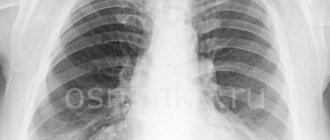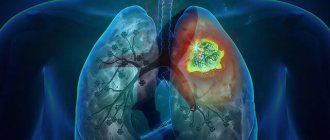According to statistics, bacterial pneumonia affects an average of about 1000 patients per 100 thousand population. This form of the disease occurs especially often in elderly people over 75 years of age or those who suffer from chronic pathologies ALENA PARETSKAYA
Pathophysiologist, immunologist, WHO expert ELENA ZARYANOVA Candidate of Medical Sciences, pulmonologist of the highest category, somnologist "SM-Clinic" »
Bacterial pneumonia is a common complication in patients treated in hospitals and clinics. In recent years, there has been an increase in severe forms that lead to death.
Causes of bacterial pneumonia in adults
Bacterial pneumonia is most often caused by bacteria, which are considered part of the microflora of the respiratory tract.
These microorganisms belong to the category of opportunistic pathogens. If the body is healthy, not weakened, the immune system is working properly, bacteria do not harm in any way. But during stress, operations, exacerbation of chronic diseases, severe acute respiratory viral infections, bacteria can become dangerous. There are two types of bacterial pneumonia - community-acquired and nosocomial. They vary greatly in the type of bacteria that causes inflammation.
In community-acquired pneumonia, the inflammatory process is usually provoked by pneumococcus, Haemophilus influenzae or streptococcus.
Nosocomial pneumonia is caused by particularly aggressive bacteria that are resistant to many antibiotics. These pathogens usually live in clinics - Staphylococcus aureus, Pseudomonas aeruginosa, Enterobacteriaceae and some others. Often such pneumonia occurs in people who undergo mechanical ventilation.
If patients suffer from immunodeficiency, pneumonia can be caused by Legionella, Mycoplasma, Pneumococcus, Haemophilus influenzae and Pneumocystis.
Bacteria penetrate into the lungs from the air, with the blood flow from inflammatory foci in the body or with the lymph flow, directly, with chest wounds. Risk factors that increase the likelihood of pneumonia are:
- frequent ARVI and influenza;
- bad habits (they weaken the immune system);
- constant stress and overwork;
- deficiency of vitamins and minerals;
- age over 65 - 70 years;
- living in areas with air pollution.
Pneumonia is likely in people with COPD, heart problems, diabetics, against the background of sinusitis, after operations and injuries.
Bacterial and viral diseases of humans. Their prevention
Many organisms belonging to different systematic groups are parasites of humans and cause diseases. Diseases whose causative agents are microscopic (viruses, bacteria and protozoa) are called infectious.
Depending on the nature of the pathogens, different types of infectious diseases are distinguished:
1. Viral, for example coronavirus, influenza, ARVI, measles, smallpox, HIV infection, viral hepatitis, tick-borne encephalitis, yellow fever.
2. Bacterial, such as plague, cholera, tetanus, anthrax, streptococcal and staphylococcal infections, whooping cough.
3. Protozoans (caused by protozoa, that is, single-celled eukaryotes), such as malaria, sleeping sickness, amoebic dysentery, toxoplasmosis.
4. Fungal, for example candidiasis, athlete's foot (foot fungus).
5. Prion (caused by special infectious proteins) - “mad cow disease” (BSE), kuru.
Pathogens of different groups are sensitive to different drugs. Therefore, drug treatment of the disease can be carried out only after diagnosing the nature of the disease and understanding the nature of its causative agent. Thus, most antibiotics act on bacterial cells, while viruses are a kind of non-cellular life form. Therefore, it makes no sense to treat viral diseases with antibiotics. Antiviral agents are used to combat viruses (it should be noted that highly specific and effective antiviral agents have appeared relatively recently and do not exist for all viral diseases).
history of infectious disease research
nature of pathogens
The idea of the contagiousness of diseases, in particular such as plague, smallpox, cholera, originated among ancient peoples. The simplest precautions against infectious patients were used even before our era. However, these guesses were still far from scientific knowledge about the nature of the disease.
Already in Ancient Greece, some philosophers expressed the idea of living pathogens of infectious diseases, but these scientists could not confirm their assumptions with any reliable facts. The outstanding ancient Greek physician Hippocrates (about 460–377 BC) explained the origin of epidemics by the action of “miasma” - infectious fumes that supposedly can cause a number of diseases.
antiseptics and asepsis
It is interesting that Pasteur, who was not a doctor, completely correctly assessed the significance of his discovery for medicine. In an address to members of the Paris Academy of Surgery in 1878, he said: “If I had the honor of being a surgeon, then, aware of the danger posed by the germs of microbes present on the surface of all objects, especially in hospitals, I would not limit myself to caring for absolutely clean instruments; Before each operation I would first wash my hands thoroughly and then hold them over the flame of the burner for a second; I would preheat lint, bandages and sponges in dry air at a temperature of 130–150 ºC; I would never use water without boiling it.”
Antiseptics (Latin “anti” - against, “septicus” - rotting) is a system of measures aimed at destroying microorganisms in a wound, pathological focus, organs and tissues, as well as in the patient’s body as a whole, using mechanical and physical methods of influence, active chemicals and biological factors.
The founder of antiseptics is considered to be the English surgeon Joseph Lister (1829–1912), who, after reading the works of Pasteur, came to the conclusion that microorganisms enter the wound from the air and from the surgeon’s hands. Convinced of the antiseptic properties of carbolic acid, he used a bandage with its solution in the treatment of an open fracture and subsequently used it to disinfect equipment and wounds. Before the advent of antiseptics, surgeons almost never took the risk of operations associated with opening the cavities of the human body, since interventions in them were accompanied by almost one hundred percent mortality from surgical infections. Professor Erikoen, Lister's teacher, stated in 1874 that the abdominal, thoracic, and cranial cavities would forever remain inaccessible to surgeons. Asepsis is a set of measures aimed at preventing the entry of microorganisms into the wound. Asepsis should be distinguished from antiseptics, which aims to destroy inflammatory agents already present in the wound. The German surgeon Ernst von Bergmann is considered one of the founders of asepsis. He proposed physical methods of disinfection - boiling, burning, autoclaving. The basis of asepsis is sterilization - the destruction of microorganisms and their spores. Sterilization should not be confused with disinfection, which does not destroy microbial spores. There are various methods of sterilization: autoclaving (pressurized steam treatment), calcination or burning with fire, immersion in antiseptic solutions, treatment with ionizing radiation (for example, in factories for the production of syringes and other disposable equipment).
Symptoms of bacterial pneumonia in adults
In many ways, the symptoms of pneumonia depend on what bacteria is causing them. The more aggressive the microbe, the more severe the manifestations. The most typical manifestations of bacterial pneumonia:
- a sharp increase in temperature, which is poorly controlled by antipyretic drugs;
- severe sweating, chills;
- a cough that is wet from the first days, with copious sputum (has a greenish or rusty color);
- chest pain, especially when breathing deeply;
- severe weakness with malaise;
- headache, aches in muscles and joints;
- pale, sallow skin color;
- low blood pressure, rapid pulse;
- frequent breathing, shortness of breath, wheezing when breathing.
If pneumonia is not treated, respiratory and heart failure, toxicosis and even death can develop. It is extremely rare to have atypical bacterial pneumonia, which has very few symptoms, they are mild, but the lungs are affected to a significant extent.
Types of bacterial skin infections
| View | Skin infection and its features |
| Staphylococcal infections | Superficial folliculitis - characterized by inflammatory processes on the skin with a white purulent center. Most often, the infection affects the hair areas on the arms, legs and thighs, usually after hair removal carried out without observing hygiene standards. May become chronic. |
| Boils are a type of deep folliculitis, characterized by an acute purulent-necrotic inflammatory process of the follicles, sebaceous glands, and connective tissue around them. Most often, the infection is found in the cervical, occipital, femoral areas, on the back and even on the face. In the latter case, it can cause serious complications such as sepsis or meningitis. | |
| Anthrax is another type of deep folliculitis. It is a particularly dangerous infection, characterized by very rapid development and acute course. It is manifested by intoxication, inflammatory processes of the skin, lymph nodes, and internal organs. | |
| Panaritium is an infection characterized by an acute purulent process that affects the fingers of the upper and, less commonly, lower extremities. It manifests itself as pain, swelling, redness, and fever. In later stages of development, surgical intervention is required. | |
| Streptococcal infections | Erysipelas is an infection caused by group A streptococcus. It is characterized by the development of inflammatory processes of a serous or serous-hemorrhagic nature, manifesting themselves as focal lesions of bright red skin with swelling, general intoxication of the body and an increase in temperature. It is one of the most common bacterial infections. |
| Streptoderma is an infection characterized by the development of serous inflammatory processes without suppuration, severe swelling of the affected area, and the rapid formation of blisters or spots prone to peeling. | |
| Abscess - characterized by the formation of a cavity in the subcutaneous fatty tissue or muscles filled with pus. The infection manifests itself with swelling, hyperemia, and pain symptoms. |
Diagnostics
The doctor focuses on the patient’s complaints and the data that he sees and hears. If the doctor listens to the chest with a phonendoscope, he will hear typical wheezing, changes in breathing and so-called crepitus (the noise of a lung affected by inflammation). Bacterial pneumonia can be confirmed by:
- blood tests indicating severe inflammation (leukocytosis, changes in protein levels, clotting);
- X-ray of the chest with areas of darkness where the lung is affected;
- CT scan of the lungs, if the diagnosis is not clear on a regular x-ray;
- culture of sputum for flora with identification of a specific bacteria (or several) and determination of sensitivity to antibiotics;
- saturation (oxygen saturation in the blood) less than 95%.
Additionally, if the case is complex, the doctor may order other tests.
Tandem with bacteria
Bacteria are a more highly developed and less vulnerable living organism, which is more difficult to outwit. However, you should not perceive bacteria as an absolute evil - a person lives in tandem with them all the time; there are even more microbial bodies in our body than our own cells. An example of beneficial bacteria is intestinal microflora. As for bacterial infection, the mechanism is triggered as follows: a pathogenic bacterium most often gains access to the body through the respiratory tract or gastrointestinal tract. This could include cuts to the skin, contaminated water, or contact with an infected person. In other words, such an infection can be picked up, for example, by holding a dirty door handle. Many pathogenic bacteria can successfully reproduce outside the body, existing comfortably on inanimate surfaces, but a virus necessarily needs a living organism to reproduce.
Most often, a person has a chance to become acquainted with the following bacterial infections: staphylococcus and streptococcus, respiratory tract infections (sore throat, pharyngitis, laryngitis), E. coli.
Modern methods of treatment
Bacterial pneumonia in mild and moderate cases can be treated at home, under the supervision of a doctor.
In severe forms - in the clinic, intensive care ward and resuscitation room. Bed rest, a light diet, and plenty of fluid intake (or intravenous administration) are indicated. The main treatment is antibiotics: the doctor selects them based on test data. Most often, penicillins, cephalosporins or macrolides are used. If these are separate forms of pneumonia, more narrowly targeted drugs are selected. Medicines are taken orally or by intramuscular injection for up to 14 days; in severe cases they are administered intravenously.
Treatment is complemented by:
- antipyretic drugs, anti-inflammatory drugs (Nurofen, Nise, Ibuklin, Rinza, Panadol);
- short course hormonal drugs;
- droppers with protein, saline solutions, vitamins and glucose;
- oxygen therapy;
- drugs for coughing up sputum (Bromhexine, ACC, Ambroxol, Fluimucil).
As the condition improves, the doctor adds breathing exercises, massages, physiotherapy, exercise therapy and subsequent rehabilitation in a sanatorium to the treatment.
Why differentiate between infections?
We all know very well that the first signs of illness are a reason to make an appointment with a doctor, but for some reason we prefer to diagnose ourselves using the Internet. What does self-medication lead to? And should a person even be able to distinguish a bacterial infection from a viral one?
“Of course, a person should know the main signs of bacterial and viral infection,” says Andrey NEVEROV, therapist, doctor of the highest category. — For example, acute respiratory viral infections are viral infections that are treated with antiviral drugs. As for antibiotics, they are used to fight bacterial infections. The specifics of treatment vary, which is why you need to consult a doctor. If antiviral therapy is not started in time, complications are likely. Against this background, a bacterial infection can also develop - pneumonia, bronchitis, endocarditis.
The problem is that infections can be mixed. As soon as immunity decreases, a “fight for food” begins in the body between bacteria and viruses. For them, the human body is a resource. Therefore, the disease can begin with a viral infection, and then a bacterial one joins it. In this case, only a doctor can choose the method of treatment, and not the phrase “okay, Google.” How to identify an infection? There are external signs by which a doctor can easily distinguish viruses from bacteria. In some cases, this also requires a blood test - this will help, for example, choose the appropriate antibiotic for a bacterial infection.








